The many lives of Fermi's magnet
by D.A. Venton
|
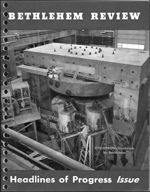 |
| 1949 The magnet's completion is the cover story for the Bethlehem Review, a news bulletin for the employees of the Bethlehem Steel Corporation (above). Forging the magnet required some of the largest ingots ever made (left). Photos courtesy of the Bethlehem Public Library |
If this magnet could talk, you'd hear some amazing stories. During its half-century career, this four-million-pound magnet contributed to experiments that changed our view of physics while serving some of the field's foremost experimenters, including Enrico Fermi.
 |
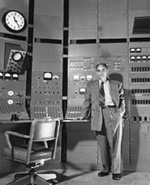 |
| 1951 Enrico Fermi at the controls of the Chicago Synchrocyclotron at the University of Chicago. Photo courtesy of the Emilio Segré archives |
The Chicago Cyclotron Magnet—also known as Fermi's magnet—has been a resident of Fermilab for 35 years. It is Fermilab's sole direct tie to Fermi, a Nobel Laureate and mastermind of the atomic age.
The magnet's roots are sunk in the Manhattan project. After completion of the bomb, the US Navy—in gratitude and enthusiasm for new physics—funded research for the project's contributors. At that time the Navy was "the best supporter of research in the country," says Courtenay Wright, a retired physicist and colleague of Fermi at the University of Chicago.
Post-WWII research
Fermi had been one of the leading scientists on the Manhattan project. At the end of the war, Fermi accepted a professorship at the University of Chicago and wanted to begin experiments on subatomic particles.
The magnet originally was part of a particle accelerator known as a synchrocyclotron. Electric fields propelled particles and the magnet bent their path. The particles cycled between the two poles of the magnet until their speed was great enough for producing high-energy collisions. The first accelerator of this type began operating in November 1946, at the University of California, Berkeley.
The construction of Fermi's magnet, begun in July 1947, took four years and $2.5 million to complete. The magnet was forged by Bethlehem Steel in Pennsylvania, using some of the largest ingots ever made, weighing about 465,000 pounds. For a brief time the Chicago Cyclotron was the highest-energy accelerator in the world, propelling particles to 450 million electron volts (MeV).
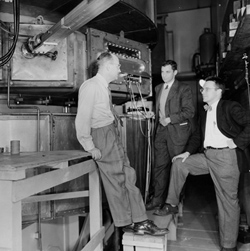 |
| 1953 Enrico Fermi (left) chats with the designers of the cyclotron magnet, Herb Anderson and John Marshall. Photo courtesy of the Emilio Segré archives |
In her memoirs, Atoms in the Family, Laura Fermi recalls her husband's joy at the completion of the magnet:
Enrico was as excited and pleased as a child who has received a new toy long dreamed of and exceeding expectations. He played with the cyclotron at all hours of the day and evening during that summer of 1951.
During the first few decades of the 20th century, scientists explained the world surrounding us using a short list of basic particles: electrons, protons, and neutrons. But discoveries with cosmic-ray experiments were beginning to complicate this simple model; the positron started things off in 1932, followed by muons (1937) and pions (1947). The post-WWII generation of accelerators, like the Chicago Cyclotron, led to discoveries that continued to unveil the complex nature of matter.
"This was the start of the discovery of the zoo of particles we now know exists," says Wright, who worked on the magnet with Fermi. "They had been showing up in cosmic rays. These are hard to do experiments with, since you can't control the source."
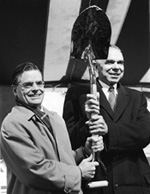 |
| 1968 Founding Director Robert Wilson (left) and Glenn Seaborg at the ground breaking for the National Accelerator Laboratory, now known as Fermilab. Photo: Fermilab |
Too many names
Experimenters searching for new particles switched from using nature as a source of data to creating particles in high-energy accelerators—the hunters and gatherers became farmers. This led to an outpouring of discoveries in the 1950s. "It was very exciting," says Wright. "We were doing all sorts of new things."
The explosion of particle discoveries was so great, Fermi famously said, "If I could remember the names of all these particles, I'd be a botanist."
During its time at the University of Chicago, the magnet steered pions and hydrogen ions toward collisions with other particles. A plot of the energy distribution in these collisions revealed a peak in the scattering cross section.
"This was the first indication of structure [within the proton]," says Fermilab physicist Hugh Montgomery, who worked on experiments involving the magnet in the 80s.
The peak, termed a resonance, told of an excited proton state—a sign that protons were made of bits and pieces. "Nobody thought they had size," says Montgomery. "But if you can excite something, clearly it's not just a single point. It must have some structure." In years to come, the quark model would begin to explain the nature of these components.
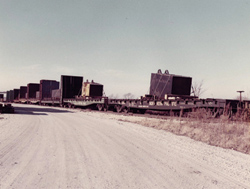 |
| 1971 Fermi's magnet arrives at Fermilab by train in 100-ton pieces. Photo: Fermilab |
A second life
After Fermi's death in 1954, other physicists continued to use the cyclotron at the University of Chicago. By 1970, however, the accelerator was obsolete. Luke Mo, an assistant professor at the time, remembers it as "still limping along, but not productive."
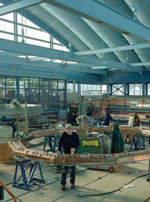 |
| 1980 In the Meson Detector Building (above), a technician inspects the superconducting coils that will be used to power the up- graded magnet. The completed coils are lifted from the building (below) and transported to the magnet. The new coils make the magnet more energy efficient. Photos: Fermilab |
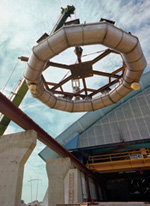 |
Recognizing the scientific value of the cyclotron's powerful magnet, Mo and others proposed a new home for the colossus: the National Accelerator Laboratory, founded in 1967 and located about 40 miles from the University of Chicago. There the magnet became the foundation of a new experiment, E-98, a muon inelastic scattering experiment in which the magnet would help to identify charged particles. Serving in a series of fixed-target experiments, the magnet played an important role in unveiling the proton's inner workings.
To move the magnet to the new laboratory, the E-98 collaboration needed someone intimately familiar with the magnet's structure. Leroy Schwartz, the magnet's original chief engineer, was about to retire from his job at the Stanford Linear Accelerator Center in California. The collaboration convinced him to come to Chicago to help the magnet relocate. "Each piece of the magnet weighs 100 tons," says Mo. "It was a very difficult job!"
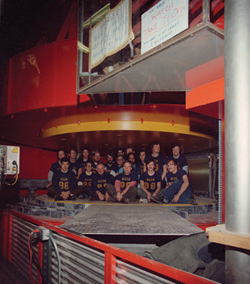 |
| 1973 Wearing t-shirts that say "Muon 98," members of the E-98 collaboration at Fermilab gather between the poles of the magnet. Photo: Fermilab |
Help from Mayor Daley
Obtaining a highway permit was one of many struggles that engineers had to overcome to move the magnet. In the end, former Mayor Richard J. Daley took an interest in the project by helping the National Accelerator Laboratory to get a permit to move the magnet by train.
The mammoth magnet found a new home inside a building now called the "Old Muon Lab," which was built around the magnet. Construction crews poured the foundation, put the magnet in place, and constructed the walls and roof around its resident. Like a phoenix, the magnet had found a new life.
In 1974, the US government honored Fermi by changing the laboratory's name to Fermi National Accelerator Laboratory. When Laura Fermi spoke at the dedication ceremony, she spoke of her husband's affection for the cyclotron magnet. "When I saw it here," Mrs. Fermi said, "the old magnet was like an old friend."
A frowned-upon prank
Robert Wilson, the founding director of what is now known as Fermilab, was proud of the magnet. To ensure that people could see it, Wilson had a "picture window" installed in the Old Muon building. The magnet was painted in traditional Fermilab colors and design: bright orange with a big yellow circle. Fermilab physicist Stephen Pordes, who worked on E-98 as an Harvard University graduate student, remembers that the design inspired a prank.
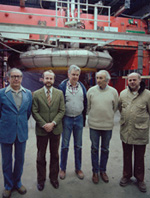 |
| 1981 The upgraded magnet has superconducting coils (left). Scientists who previously used the Chicago Cyclotron Magnet visit the magnet in March of 1981 (top). Photos: Fermilab |
| 1983 The magnet moves again. Its new home, named the New Muon Lab, is constructed around it. Photo: Fermilab |
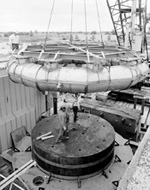 |
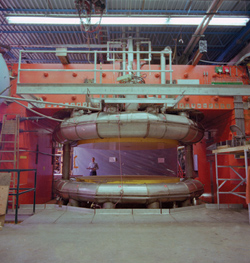 |
"One Saturday night in the early 70s—when the Smiley was becoming part of pop culture—some very skillful technicians came in the lab and put two huge black dots, a mouth, and a nose, made of black tape—part of every physicists tool-box," he says. Wilson, not amused, said Monday morning, "You're not getting any beam till that's off." Retelling the story, Pordes laughs, "That was when we were very young."
Experiments in the 1980s led to a second reincarnation of the magnet. Scientists converted the device from an electromagnet operating at room temperature to a magnet with superconducting coils operating at minus 450 degrees Fahrenheit. The switch to superconducting technology dramatically reduced the energy costs and allowed the magnet to be used for further fixed-target experiments.
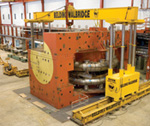 |
| 2006 In September, workers disassembled the magnet (top). Its pieces are now stored in Fermilab's "bone-yard" (bottom). Photos: Reidar Hahn, Fermilab |
An ugly turn
Scientists remember this switch with mixed emotions. For some, the retrofitting took away the magnet's original appeal. Explains one physicist, "This is not a diplomatically correct thing to say, but [the magnet] was completely ruined when it was changed to superconducting. It used to be very nice—you could push a button and in minutes it was at full field. When it became superconducting, it was ugly and took weeks and weeks to come online."
In all, about seven experiments used the Chicago Cyclotron Magnet at Fermilab. It was last used in 1991. "When it was retired, we didn't know it would never be used again," says Pordes. "Its retirement is symbolic of the death of the fixed-target era at Fermilab. People became interested in higher-energy collisions."
During the fixed-target era, the magnet drew experimenters to Fermilab from all over the world. "It was a host, an attractor," Pordes says, "If you wanted to do an experiment that needed the ability to bend high-energy particles, it was there."
Last summer, Fermi's magnet was moved out of its experimental hall and retired to a holding area on the Fermilab site. A number of physicists who had worked with the magnet stopped by to bid farewell, "for old time's sake."
While Fermilab has no future plans to use the magnet, the lab will keep the magnet as a historically important artifact. If a future experiment needs a magnet, it may yet find another reincarnation.
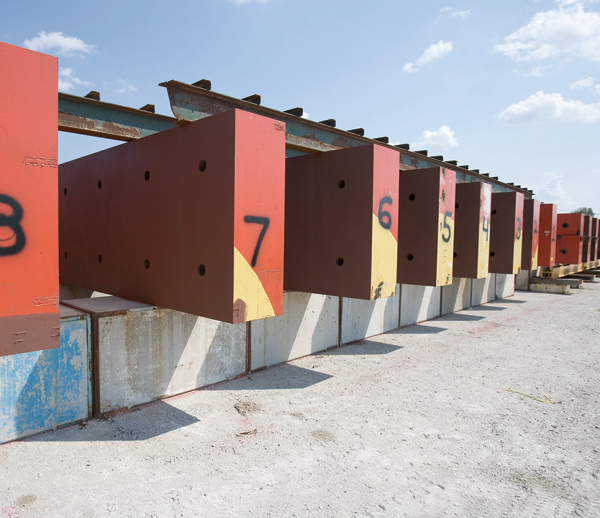 |
Click here to download the pdf version of this article.







